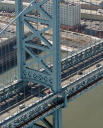The Ben Franklin Bridge
 Farmers in southern New Jersey waited more than a century for a fixed crossing to Pennsylvania. The first plan for a Delaware River bridge between Camden and Philadelphia was developed in 1818, when the proposed "Farrand and Sharp's Bridge" called for a low-level, multi-span bridge with several draw-style openings to permit passage. This early plan was followed later, in the 1840s, by two separate plans for suspension bridges. However, none of the nineteenth-century proposals attracted serious interest.
Farmers in southern New Jersey waited more than a century for a fixed crossing to Pennsylvania. The first plan for a Delaware River bridge between Camden and Philadelphia was developed in 1818, when the proposed "Farrand and Sharp's Bridge" called for a low-level, multi-span bridge with several draw-style openings to permit passage. This early plan was followed later, in the 1840s, by two separate plans for suspension bridges. However, none of the nineteenth-century proposals attracted serious interest. It took the introduction of the automobile to resurrect interest in the proposed Delaware River Bridge. In 1913, the city of Philadelphia formed the Penn Memorial Bridge Committee to study a possible fixed crossing. The desire for a bridge over the Delaware River was long held by New Jersey farmers who wished to transport their produce to Pennsylvania markets. And Pennsylvania farmers that wished to do the same in New Jersey. Between 1908 and 1911, New Jersey passed laws stipulating that three or more counties could join to initiate a bridge, and at least one bordered the river to be crossed. Gloucester, Camden and Burlington counties eventually came up with the funds to study the proposed Delaware River Bridge.
In 1918, the states of New Jersey and Pennsylvania established commissions for a Delaware River span, and hired a firm to make a consulting-engineering study. The firm’s report recommended that a suspension span be constructed from the intersection of Vine and Race Streets in Philadelphia, to Linden Street in Camden. On December 12, 1919, the Delaware River Bridge Joint Commission was established, comprising representatives from PA and NJ.
The next major decision to be made concerned the choice of construction types: suspension or a cantilever. For the suspension bridge design, the main span was to be 1,750 feet, flanked by side spans of 719½ feet. For the cantilever bridge design, the main span was also to be 1,750 feet, but was to be flanked by shorter side spans of 500 feet. Both bridges were to have mid-span clearances of 135 feet over the water. By 1922, the suspension design was selected and approved by the Delaware River Bridge Joint Commission.
As was common with bridges of the day, deep stiffening trusses were incorporated into the design of the bridge. These trusses were placed above the main roadway deck. Together with the two main cables, the stiffened deck could support a load of 60,000 tons.
The main roadway originally accommodated six lanes of vehicular traffic and two streetcar tracks. (The streetcar tracks were soon converted into two additional vehicle lanes.) Two rapid transit tracks were constructed on outboard structures on either side of the roadway, but were left unused when the bridge opened. Above the rapid transit tracks were two pedestrian walkways.
The anchorages on either side give the bridge an appearance of massiveness. Each of the granite anchorages to which the steel cables are attached covers three-quarters of an acre. The two anchorages, which together required 216,000 tons of masonry, rise 175 feet above the ground. Their "toeholds" sink into the earth 65 feet into the Philadelphia side, and 105 feet into the Camden side. On the western anchorage are carved the seals of the state of Pennsylvania and the city of Philadelphia, and on the eastern anchorage are carved the seals of the state of New Jersey and the city of Camden.
The entrances to the bridge were also designed to be impressive. Four bronze "winged victory" statues - two each adorning the Philadelphia and Camden plaza portals - were erected. In 1951, the Delaware River Port Authority (D.R.P.A.) was established by Pennsylvania and New Jersey. The new two-state commission was to oversee improvements to the Delaware River Bridge--which was renamed the Benjamin Franklin Bridge--and to construct new crossings over the Delaware River in the future.
For more South Jersey History, visit our History page.
advertisement

Author: R. Cohen
Archives
Collingswood
A Southern Mansion
Light up the Night
Dining Alfresco
Sink or Swim
Throwing Shade
The Outdoors in Order
The Foundation
A New Spin on Swim
Gloucester Township
Wonderful Water
The Foundation: June, 2015
Community Connection: Moorestown
Things to Do
Cinnaminson
More...







